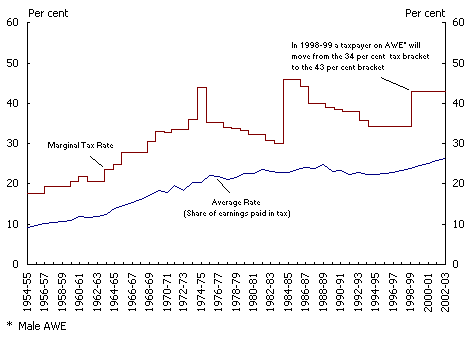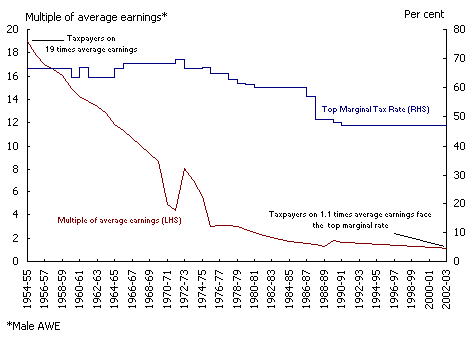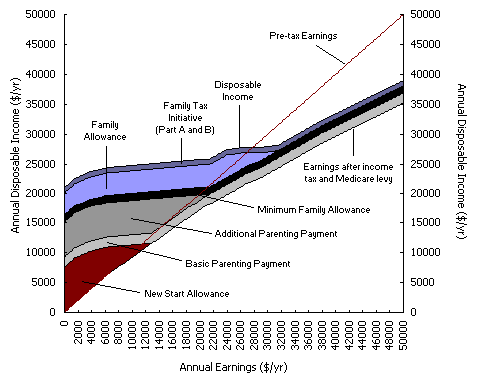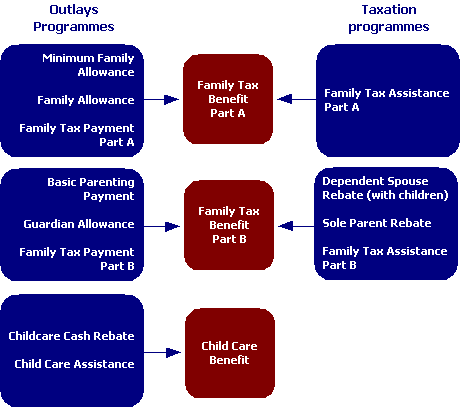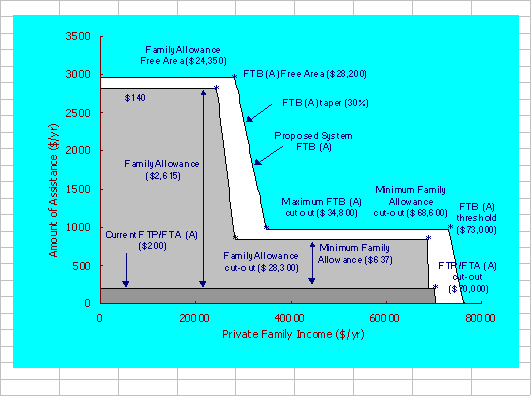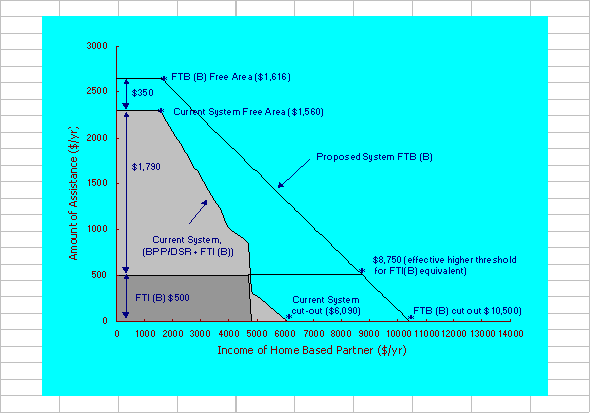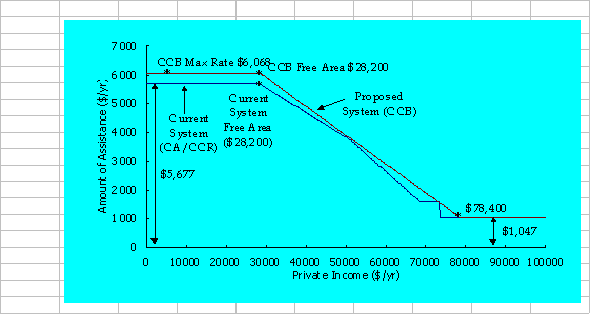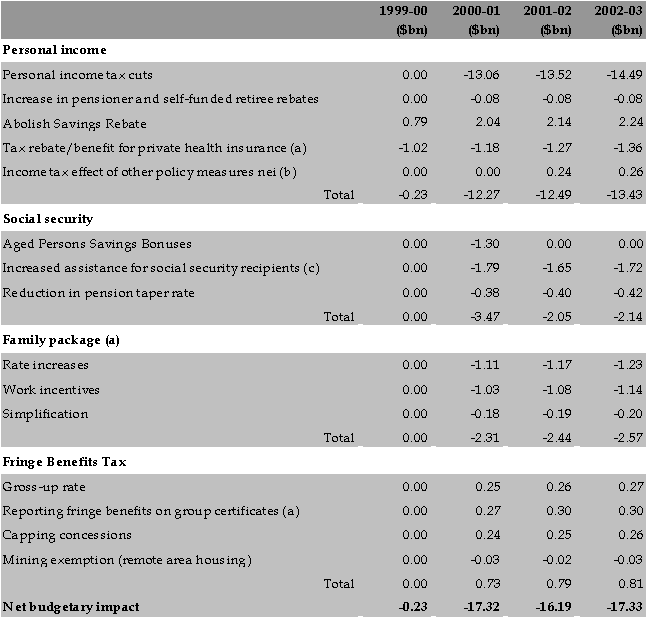Reforms to income tax and social security
Overview |
The personal income tax and social security systems are complex and reduce incentives to work and save, particularly for low and moderate income families.
Income tax rates are being reduced, assistance for families is being increased and reformed and income support payments increased. The structure of both systems is being simplified - especially as it affects families. Reform will increase incentives and make the system easier to understand. |
The problem
Income tax and social security arrangements destroy incentives
Income tax rates are too high. Twelve months ago, a person on average earnings paid tax of 34 cents for each additional dollar they earned. Today, the figure is 43 cents. Within a few years it will rise to 47 cents, unless something is done. The average tax rate - the amount of income tax that people pay as a percentage of their income - has also been increasing for middle income earners over the past 40 years.
These trends are illustrated in Figure 1.1 below. The average tax rate paid by middle income earners has increased steadily. The marginal tax rate — the tax payable on an extra dollar of income — has also trended up.
Figure 1.1:
Average and marginal rates
for those on average earnings are increasing
The Government is committed to maintaining a progressive income tax system so that those in a position to make a relatively greater contribution to raising revenue do so. However, the current system means that many moderate income taxpayers are now paying, or soon will be paying, the top marginal tax rate of 47 cents in the dollar, which takes effect from incomes of $50,000 a year. In 1954-55, the top marginal tax rate was paid by a taxpayer who earned 19 times average earnings. By 1999-00, under the current system, it is estimated that the top rate will be paid by a taxpayer earning 1.2 times average earnings and will fall to 1.1 times average earnings by 2002-03. This is further illustrated in Figure 1.2. It contributes to an unfair income tax system that penalises incentives to work and save.
Figure 1.2:
Average earners are approaching the top marginal rate
These problems have come about for several reasons. In the absence of a comprehensive indirect tax system, the personal income tax system has been required to shoulder a greater share of the revenue raising load than would otherwise be the case. This results in higher tax rates for all taxpayers.
Furthermore, the high income tax rates associated with this imbalance provide greater incentives for individuals to undertake aggressive tax planning. This leads to an even more fragile and narrow revenue base, requiring higher tax rates to raise the revenue needed to provide government services.
But these high marginal tax rates create disincentives for people to:
- undertake extra work or seek advancement;
- undertake additional education or training, as the after-tax rewards of a higher skilled/higher paying job are reduced; and
- increase personal savings, as the returns to saving are also subject to high marginal tax rates.
Low and middle income families are especially disadvantaged
These effects are compounded when the social security system is also taken into account.
It is a commonly held view that the highest marginal tax rates are paid by people at the top end of the income distribution. However, the interaction between the income tax and social security systems means that many low and moderate income families keep only a few cents of each additional dollar that they earn. In some instances, these families can actually go backwards - that is, experience a reduction in disposable income - as their earned income goes up.
This is the area where work disincentives bite the hardest. It is essential that the tax and social security systems not stand in the way of low and moderate income working families who want to work harder to improve their standard of living. Work choice should not be driven by the disincentives created by the current interaction of the tax and social security systems.
The impact of the current work disincentives and the net financial return from working for a single income family with two children aged 4 and 7 years under the current system is illustrated in Figure 1.3. Without any earnings, the family receives social security and family payments totalling just over $21,000. Disposable income increases only slowly as earnings increase, because tax is paid but, more significantly, social security and family payments are withdrawn. For some low income working families, the effective marginal tax rates are 85.5 per cent or more because they pay tax of 34 cents, Medicare levy of 1.5 cents and they lose family payments at a rate of 50 cents for each extra dollar of income that they earn.
Figure 1.3:
Disposable income for families increases slowly as earnings increase, up to earnings of $32,000 a year
The return from additional work is not sufficientRichard and Fiona have two children, Julie and Jack aged 7 and 4 years. Richard is unemployed and works casual shifts at the local pub, earning $120 a week. The pub owner has offered Richard a full-t After working for a year Richard is considering undertaking a TAFE course to improve his chances of gaining a job as a bar manager. The position pays a salary of $33,000 a year ($635 a week). But if Richard takes the position the family income will increase by less than $47 a week. He gets to keep only 22 per cent of his increased earnings. |
This example understates the lack of incentives for low income families. First, some families can actually go backwards as their income increases. For example, a single income couple family with two children faces an effective tax rate of 105 per cent between $27,600 and $29,600 a year of private income. In addition, for unemployed people, entering the workforce brings additional work related costs. They can also lose access to a considerable range of non-cash benefits that are withdrawn when people enter the full-time workforce.
These disincentive effects are largely a consequence of a targeted social security system which focusses assistance on those most in need. To target such assistance on low income families, benefits must be withdrawn as income increases - but this reduces the amount of money that people effectively keep out of their earned income. While targeting is essential in order to direct assistance to those in greatest need and to contain costs, it can reduce work incentives. The tax and social security systems need reform to get a better balance between targeting and enhancing work incentives.
Some people don't pay their fair share
High marginal rates encourage tax minimisation
As well as reducing work incentives, high marginal tax rates provide incentives for people to take advantage of opportunities to reduce their tax liabilities. This fosters the perception (often real) that some people are not paying their fair share of the tax burden or are exploiting the social security system.
Such practices are used not only by the very wealthy. With the top marginal rate of 47 per cent taking effect at $50,000 a year, people earning not much more than average earnings can gain considerably by reducing their taxable income through the use of legal tax minimisation schemes like trust structures and other forms of financial planning.
The poor return from extra effort for low and moderate income earners (discussed above) also creates incentives for people to avoid or evade tax and cheat on the social security system by working in the underground economy.
Salary sacrifice is used to lower tax, access social security and avoid Government surcharges
A major problem in this area is the rapidly expanding practice of salary sacrificing - taking a portion of salary in the form of fringe benefits, such as a car. By converting some salary to non-salary fringe benefits, a taxpayer can retain access to some social security entitlements, such as Family Allowance, because of the limited coverage of fringe benefits in the income tests for such entitlements. Depending on the income level, other elements of the tax and social security systems, such as the Medicare surcharge, Superannuation Contributions Surcharge and child support liabilities, can be avoided or reduced.
Such practices undermine the fairness of the tax system. Moreover, they mean that other taxpayers have to pay more to make up for the revenue that is lost. Put simply, some employees have no options for salary sacrificing, while others are provided with a menu of salary package options and choose the ones that are best for their individual circumstances. Such unfairness in the system needs to be addressed.
The income tax/social security system is too complex
The systems have not been integrated
The tax and social security systems have become extremely complex over the last decade or so. There are currently over 30 major types of income support payments and supplements. Some of these are taxable, others are non-taxable and the tax status of some depends on the characteristics of the recipients. In addition, tax liability is affected not only by the tax scale and the Medicare levy, but also through a myriad of rebates and possible deductions.
This complexity is the result of tighter targeting of the social security system over time, the changing structure of society, the need to close loopholes and the ability of different groups to obtain preferential treatment. The tax system has also undergone both major and minor change over this period for similar reasons.
The complexity increases further when the combined effect of the two systems is examined. The interaction between them needs to be simplified to make them easier to understand and deliver to the Australian people.
Family assistance is a classic example of complexity
This complexity is most evident in the current assistance provided to families. Table 1.1 details the major forms of government assistance to families through the income tax and social security systems, apart from those (such as Newstart Allowance or Parenting Payment) which provide income support where family income is low.
Table 1.1:
Family assistance is delivered in a piecemeal fashion
Assistance through outlays |
Assistance through the tax system |
| Minimum Family Allowance | Family Tax Assistance Part A |
| Family Allowance | Dependent Spouse Rebate |
| Family Tax Payment Part A | Sole Parent Rebate |
| Guardian Allowance | Family Tax Assistance Part B |
| Basic Parenting Payment | |
| Family Tax Payment Part B | |
| Child Care Assistance | |
| Childcare Cash Rebate |
A number of these forms of assistance have virtually identical objectives:
- Minimum Family Allowance, Family Allowance, Family Tax Payment Part A and Family Tax Assistance Part A are all provided to assist families with the direct costs of raising children;
- Basic Parenting Payment, Guardian Allowance, Family Tax Payment Part B, the Dependent Spouse Rebate, Family Tax Assistance Part B and the Sole Parent Rebate are provided to assist single income families, including sole parents; and
- Child Care Assistance and the Childcare Cash Rebate are provided to assist families with the costs of childcare out
side the home.
This array of assistance is confusing for Australian families, requiring them (or their advisers) to navigate their way through a maze of different and complex eligibility criteria, different income tests and different delivery mechanisms in order to obtain assistance.
In some cases, families need to choose whether it is more advantageous to them to claim essentially the same form of assistance through the tax system or the social security system, with the risk that they don't get their full entitlement because of the complex and different rules applied to assistance through each system.
There is a need to simplify the structure and delivery of assistance for families. The number of programmes could be reduced substantially with only one payment dealing with each target group and their delivery being made through one agency.
The goal
Incentives to work and save
We need to put in place a coherent income tax and social security system for the twenty-first century. We need a system to ensure that all Australians - especially low and moderate income families - have much stronger incentives to work and save.
A fair and simple system
The community's faith in the personal income tax and social security systems, and therefore their sustainability, must be restored by implementing:
- a system that is simple and transparent, where income support and family payment entitlements are clearly understood and easily dealt with; and
- a system in which people pay their fair share and do not have access to loopholes.
The strategy
The Government's reform of the personal income tax system and the social security system is being undertaken on three fronts.
Lower tax rates for all Australians
To address the problems associated with low work incentives for all Australians, income tax rates are being cut and thresholds improved.
To make the tax system fairer for all taxpayers, reforms are also being made to Fringe Benefits Tax (FBT) arrangements.
Reform of family assistance
To help families raise their children, assistance for them is being increased, work incentives for low and middle income families are being improved and the structure and administration of family assistance is being revamped to simplify it.
Increased social security payments
To ensure that the gains of tax reform are shared widely, pensions and benefits are being increased in real terms and the pension income test is being eased to improve work and savings incentives.
The plan
Lower income tax rates
The Government's reforms of the income tax system provide tax cuts across-the-board, with reductions in marginal tax rates for about 95 per cent of all taxpayers.
Table 1.2 shows the current income tax scale and the one that will take effect from 1 July 2000.
Table 1.2:
Income tax scale
Current scale* |
New scale |
||
| Taxable income | Tax rate (%) | Taxable Income |
Tax rate (%) |
| 0-5,400 |
0 |
0-6,000 |
0 |
| 5,401-20,700 |
20 |
6,001-20,000 |
17 |
| 20,701-38,000 |
34 |
20,001-50,000 |
30 |
| 38,001-50,000 |
43 |
||
| 50,001+ |
47 |
50,001-75,000 |
40 |
| 75,001+ |
47 |
||
* In addition, the $150 low income rebate applies to both the current and new scales.
The key features of the new tax scale are:
- an 11 per cent increase in the tax free threshold to $6000 which is worth up to $120 a year in reduced tax. This helps all taxpayers but is of relatively greater benefit to low income taxpayers;
- a reduction in the lowest marginal tax rate from 20 per cent to 17 per cent. This, too, helps all taxpayers but is of particular benefit to low income taxpayers;
- large tax cuts for middle income earners with income between $30,000 and $50,000 a year through the replacement of the 34 per cent and 43 per cent tax rates with a 30 per cent rate:
- this will mean that around 81 per cent of taxpayers will have a top tax rate of 30 per cent or less, compared to around 30 per cent of taxpayers currently;
- a single taxpayer earning $30,000 a year will receive a tax cut of $842 a year or $16 a week, representing a 3.6 per cent increase in after tax income;
- a person on projected average earnings of $45,000 in 2001-02 will receive a tax cut of $2,072 a year or $40 a week, representing a 6.4 per cent increase in after tax income; and
- a $25,000 increase (to $75,000) in the level of income at which the top marginal rate of 47 per cent takes effect. The $75,000 threshold will be equal to around 1.7 times average earnings. This will ensure that average earners do not drift into paying the top marginal tax rate, which would otherwise have occurred early in the next century.
Table 1.3 shows the tax cuts for various levels of taxable income.
Table 1.3:
Amount of tax cuts
Taxable income |
Tax cut$ per year |
Tax cut$ per week |
% change in tax payable |
| $6,000 |
120 |
3.45 |
-17.4 |
| $20,000 |
540 |
10.36 |
-17.6 |
| $30,000 |
842 |
16.15 |
-12.6 |
| $40,000 |
1,422 |
27.27 |
-13.7 |
| $50,000 |
2,722 |
52.21 |
-18.3 |
| $60,000 |
3,422 |
65.63 |
-17.4 |
| $75,000 |
4,472 |
85.77 |
-16.6 |
| $85,000 |
4,472 |
85.77 |
-14.1 |
| $90,000 |
4,472 |
85.77 |
-13.1 |
| $100,000 |
4,472 |
85.77 |
-11.4 |
These income tax cuts, totaling over $13 billion a year, provide a 14 per cent reduction in total personal income tax collections. They will break the historical trend of increases in the average tax rate for average earners, shown earlier in Figure 1.1.
Low and middle income taxpayers, in particular, will keep a higher proportion of the earnings they receive after tax, providing them with greater rewards for their work efforts and improved incentives to better their financial position through overtime, promotion and training.
In view of the major impact that the across-the-board reductions in tax rates will have on incentives to work and save, and in view of the cut in marginal tax rates on saving, the savings rebate will be terminated with effect from 1999-00.
Further details of the benefits of the income tax cuts being provided to individuals and families are provided in Chapter 5.
Private health insurance initiative
In order to assist families and individuals with the cost of private health insurance, a new 30 per cent tax rebate/benefit will be introduced from 1 January 1999. It will not be means tested and will be at a rate of 30 per cent of expenditure on private health insurance, including ancillary cover.
The new tax rebate/benefit will be available in addition to the existing medical expenses rebate and can be received as a tax rebate or as a direct payment from the Government.
Under the new tax system, the new tax rebate/benefit is as generous or more generous than full income tax deductibility for health insurance premiums for more than 80 per cent of taxpayers.
The Family Assistance Office (described later in this chapter) will administer the tax rebate/benefit. Taxpayers will be able to claim the rebate on assessment. Alternatively, the Government will ensure that a direct payment can be claimed from an extensive network of shopfronts or arranged through the mail.
Those families and individuals who pay for private health insurance through a single premium payment can seek the benefit as a payment by providing proof of purchase to the Family Assistance Office. For those who pay for their insurance by instalment, the benefit will also be available by instalment.
The new tax rebate/benefit will replace the existing Private Health Insurance Incentive Scheme (PHIIS). The PHIIS will continue to operate up to the introduction of the new rebate/benefit, with PHIIS recipients entitled to part year assistance in respect of 1998-99.
The increased level of assistance to private health insurance members provided under the new tax rebate/benefit, and the broader access to the incentive, are expected to lead to a significant increase in private health insurance membership.
Reforming the Fringe Benefits Tax provisions
The Government is reforming the Fringe Benefits Tax (FBT) provisions to make the system fairer for all taxpayers.
The reforms have four elements:
- improving income tests for surcharges and government benefits by requiring employers, from the 1999-00 FBT year of income, to identify on group certificates the grossed-up taxable value of an employee's fringe benefits that are part of their remuneration package or award, where the value of the benefits exceeds $1,000:
- while tax liability for such benefits will remain with the employer (under FBT), their value will be included as income for determining liability for tax surcharges (such as the Medicare levy surcharge and the superannuation contributions surcharge) and income related obligations such as child support;
- the non-grossed-up amount for a wider range of fringe benefits will also be included in assessing entitlement to certain income-tested government benefits (ie Family Allowance and the parental income test for Youth Allowance);
- stopping overuse of the concessional FBT treatment of public benevolent institutions and certain other not-for-profit organisations. This will be done by limiting, for each employee, the value of fringe benefits eligible for concessional treatment to $17,000 of grossed-up taxable value per employee of such organisations (equivalent, in broad terms, to the grossed-up value of an average 6 cylinder car and some additional minor benefits). Any amount above this limit will be subject to the normal FBT treatment;
- extending FBT to benefits in excess of $1,000 a year provided by companies to their shareholders or by trustees to trust beneficiaries, where the benefits are not taxed currently; and
- extending the FBT exemption for remote area housing pr
ovided by mining industry employers to their employees. This provides the mining industry with the same treatment that applies currently to primary producers.
The last three measures will take effect from the 2000-01 FBT year.
In addition, the FBT gross-up rate will be changed to ensure neutrality of treatment between fringe benefits and cash salary following the introduction of the GST. The new gross-up rate will take effect from July 2000.
Improving assistance for families
To accompany the changes to the personal income tax system, the Government will introduce substantial reforms to the various forms of assistance provided to families through the income tax and social security systems.
These reforms will provide extra assistance to families in recognition of the extra costs involved in bringing up children and the sacrifices that families make. They boost the amount of the income tax cuts that families receive, substantially improve work incentives for low and middle income families and greatly simplify the complex array of assistance provided currently to families.
Increasing the amount of assistance
Extra assistance is provided to families by extending the Family Tax Initiative (FTI), introduced by the Government in January 1997, at a cost of over $2 billion in 2000–01.
The FTI currently provides an increase in the tax free threshold of $1,000 for each dependent child, plus an extra $2,500 for single income families with a child aged under 5 years. From 1 July 2000, these thresholds will be doubled to $2,000 and $5,000 respectively.
The effect of this is that all single income families (including sole parents) with a child under 5 years will have an effective tax free threshold of $13,000. This is made up of the new $6,000 tax free threshold plus $2,000 for one dependent child and the further $5,000 provided to single income families with young children. Overall, such families have a tax free threshold that is more than double the general $6,000 threshold.
For families, the doubling of the FTI means:
- an increase in assistance of $140 a year (a 70 per cent increase) for each dependent child; and
- on top of this, an extra $350 a year (a 70 per cent increase) for single income families with a child aged under 5 years.
Table 1.4 shows the increases in assistance for different types of families from July 2000 and the total increase in assistance that will have been provided since January 1997 when the Government introduced the FTI.
Table 1.4:
Family Tax Initiative will be increased in July 2000
|
Increase in assistance ($/yr) |
|
|
Including increase in January 1997 |
|
| Single-income family | ||
| one child under 5 years |
490 |
1,190 |
| 2 children, one under 5 years |
630 |
1,530 |
| 2 children, aged 5 years or more |
280* |
680* |
| 3 children, one under 5 years |
770 |
1,870 |
| 3 children, aged 5 years or more |
420* |
1,020* |
| Dual-income family | ||
| one child |
140 |
340 |
| two children |
280 |
680 |
| three children |
420 |
1,020 |
| * Single income families with a youngest child aged 5-16 years receive an extra $61 a year from other elements of the families package. See page 54 for details. |
||
Improving incentives for families to work - including the unemployed
The current system of assistance for families, particularly the overlap between the various income tests for benefits, results in disincentives for low and moderate income families to work. Many families face an effective marginal tax rate of 85.5 per cent or more if they increase their income.
To remove these overlaps and disincentives, the Government will, from July 2000, ease substantially the income test for Family Allowance by:
- increasing the level of income at which it begins to be income tested from $24,350 a year (for one child) to $28,200 a year; and
- reducing the income test taper rate from 50 per cent to 30 per cent.
These measures represent a major social reform that provides substantial extra income to help lower income families raise their children and improves work incentives. They ensure that unemployed families will not incur a sudden drop in Family Allowance (and hence income) when they leave the income support system, improving incentives for them to obtain a full-time job.
At the same time, these measures, combined with the tax cuts, will ensure that low income working families will have much better incentives to improve their circumstances. For example, their effective marginal tax rate will drop from 85.5 per cent to 61.5 per cent over a substantial range of income. As outlined in the example below, low and moderate income families will get to keep considerably more income than is currently the case.
The increase in work incentivesRecall Richard and Fiona, with the two children, Julie and Jack (see earlier in this chapter). Following the reform to tax rates and family assistance, the return from working has been significantly increased. Under the current system, a move from part-time to |
Simplifying the structure and delivery of Family Assistance
Building on these increased levels of assistance and greater work incentives for families, the Government proposes to greatly simplify the structure of assistance for families, with effect from July 2000. Prior to implementation, the Government will consult with community organisations on the details of the new structure.
The new structure will reduce the types of assistance for families through the tax and social security systems from twelve to three. This is shown in Figure 1.4.
Figure 1.4:
Twelve family benefits simplified to three
Family Tax Benefit, Part A
First, it is proposed that the four forms of assistance provided to help families with the costs of raising children will be merged into one benefit, the Family Tax Benefit, Part A (FTB(A)). This will:
- have the same rate structure as the programmes it replaces (ie maximum and minimum rates), but with the extra $140 a year for each dependent child outlined above;
- use the relaxed income test for Family Allowance outlined above for the maximum benefit (ie a threshold of $28,200 a year and a 30 per cent taper rate);
- replace the ‘sudden death’ income tests for minimum Family Allowance, Family Tax Payment (FTP) and Family Tax Assistance (FTA) with a single relaxed income test for the minimum FTB(A) of $73,000 a year (plus $3,000 a year for each child after the first) and a taper rate of 30 per cent;
- abolish the assets test that applies currently to Family Allowance and minimum Family Allowance; and
- be increased annually in line with movements in the Consumer Price Index (CPI) in the same manner as applies currently for Family Allowance.
Family Tax Benefit, Part B
Second, it is proposed that the six forms of assistance provided to single income families (including sole parents) will be merged into a Family Tax Benefit, Part B (FTB(B)). This will:
- have a similar rate structure to the current system (ie with the level of assistance being higher where the youngest child is aged less than 5 years), but with
- the additional $350 a year for single income families (including sole parents) with a child under 5 years outlined above;
- an additional $61 a year, where the youngest child is aged 5-16 years, meaning that a single-income family with two children aged over 5 years receives an additional $341 a year comprising $280 as set out in Table 1.4 plus an additional $61;
- for couples, replace three different income tests on the non-working partner's income with one test that has a free area of $1,616 a year and a 30 per cent taper (thereby increasing the cut-out point for assistance from $6,090 a year to $10,500 for a family with a child aged under 5 years):
- this will greatly improve work incentives for primary carers (who are usually women);
- abolish the FTA/FTP income test on the working partner's (or sole parent's) income that applies currently from $65,000 a year; and
- be indexed annually in line with movements in the CPI in the same manner as applies currently to Family Allowance.
Child Care Benefit
Third, it is proposed that the two forms of assistance available to help families with the costs of childcare outside the home will be merged into one. The new benefit will greatly simplify government assistance for childcare costs, enabling families to receive all assistance with childcare through the one programme and under one set of rules. The Child Care Benefit will provide:
- maximum assistance (for 50 hours of work-related care per week) of $116.40 a week per child in formal care, with an additional $11 a week loading where there are 2 children in care and a $32 a week loading for 3 or more children in care;
- for informal work-related care, the maximum level of assistance is $20.10 a week per child in care (for 50 hours of care);
- a single income test, with a family income threshold of $28,200 a year (for formal care) and taper rates of:
- 10 per cent for one child in care;
- 15 per cent and (above $66,000) 25 per cent for 2 children in care;
- 15 per cent and (above $66,000) 35 per cent for 3 or more children in care;
- the income test will not apply for incomes above $78,400 (one child in care). This will, in effect, maintain entitlements to assistance (equivalent to that available under the Childcare Cash Rebate at the 20 per cent rate) for higher income families.
Compared to the current system, the Child Care Benefit will provide an increase in the maximum level of assistance of $7.50 a week. This will be of particular benefit to 200,000 lower income families, who receive the maximum level of assistance.
Further detail on the new, simplified structure is provided at the end of this chapter.
Delivery of family assistance
The Government's reform of family assistance will also simplify and integrate the delivery of such assistance to Australian families.
Currently, the 12 forms of assistance for families outlined in Figure 1.4 are delivered through a combination of Centrelink, the Tax Office and the Health Insurance Commission. This is inefficient. But more importantly, it is confusing for families, making it very difficult for them to understand the range of assistance available to them, to easily access their entitlements and to deal with the myriad sets of rules and regulations used by each organisation.
To break out of this maze, a new Family Assistance Office (FAO) will be set up within the Tax Office to deliver the new simplified set of family assistance programmes. The FAO will be a joint venture between Centrelink and the Tax Office that will specialise in delivering assistance to families. It will enable families to deal with just one agency and one set of rules. The primary carer in the family (generally the mother) will have a choice as to how they wish to receive their assistance - either through regular fortnightly payments to their bank account, as reduced tax deductions from their (or their partner's) pay-packet or as an end-of-year lump sum through the tax system.
Providing extra assistance for social security recipients
and other lower income groups
A fundamental objective of the Government's tax reform package is to provide a tax system that is fairer for all Australians. Many lower income individuals and families will benefit from the new income tax scale and the family assistance package. However, some low income groups, such as age pensioners with no private income, do not pay income tax currently and, hence, cannot benefit from the Government's tax cuts.
Increasing pensions and benefits
To ensure that such groups receive their fair share of the benefits of tax reform, the Government will increase the adequacy of all social security and veterans' pensions a
nd other income support payments and allowances, with effect from July 2000. The payments that will increase are listed on the next page.
It is estimated that by 2001-02 the overall impact of the tax package will have added 1.9 per cent to the CPI, excluding new house prices (which will be compensated by a new First Home Owners' Scheme) and tobacco. But because not all of the indirect tax cuts commence in 2000-01, the CPI impact in that year is likely to be a little higher - perhaps as much as half a percentage point. In order to ensure that no pensioner or beneficiary is disadvantaged by this, the Government will provide from July 2000:
- a 4.0 per cent increase in the maximum rate of all income support payments provided to social security and veterans' pensioners, other social security recipients and students in receipt of Commonwealth income support, including additional payments and allowances such as Child Disability Allowance and Mobility Allowance; and
- a 2.5 per cent increase in the income test free areas applied to social security, veterans' and student income support payments.
These increased rates of assistance raise the maximum level of all income support payments by more than the impact of tax reform on prices (as measured by the CPI), overcompensating recipients for the cost of living effects of the changes to indirect taxation arrangements. The Government will ensure that income support payments are 1.5 per cent higher than they would have been had the normal automatic indexation arrangements applied. This represents an estimated real increase of $5.80 per fortnight in the maximum single rate pension and $4.80 per fortnight for each of a married couple in July 2000. In addition, the Government will continue to ensure that the single rate of pension does not fall below 25 per cent of male total average weekly earnings.
Commonwealth income support payments |
|
| Payments increasing
The following government payments will increase as part of ensuring that all Australians benefit from the new tax system:
|
Note: Payments for families not included above will be increased as part of the family package. |
Easing the pension income test
The income test for pension payments will also be eased, with effect from July 2000, by reducing the taper rate from 50 per cent to 40 per cent. This will assist all 845,000 part-rate pensioners by enabling them to keep an extra 10 cents of pension for every dollar of private income they receive above the income test free areas. It will be of particular benefit to age and service pensioners and to self-funded retirees with modest incomes who will become eligible for a part-rate pension as a result. More broadly, the measure will improve incentives to save for retirement by increasing the returns from such saving at the time that people retire. The measure will also improve work incentives for sole parent pensioners.
Introducing an Aged Persons Savings Bonus and Self-Funded Retirees Supplementary Bonus
In addition, the Government will provide special payments to older Australians - pensioners and self-funded retirees - with income from savings. The Aged Persons Savings Bonus and Self-Funded Retirees Supplementary Bonus will help maintain the value of the savings and retirement income of older people.
The maximum value of the Aged Persons Savings Bonus will be $1,000 per person while the Self-Funded Retirees Supplementary Bonus will provide up to an additional $2,000 per person to eligible people who are of age pension age but not in receipt of a social security or service pension. This additional amount will assist self-funded retirees who will not benefit from the increases in the maximum rates of age and service pensions.
These bonuses will:
- provide an untaxed Aged Persons Savings Bonus of up to $1,000 to each Australian resident aged 60 or more on 1 July 2000 with personal income from savings and investment (including superannuation pensions and annuities) and whose total income in 1998-99 or 1999-00 is less than $30,000;
- provide an additional untaxed Self-Funded Retirees Supplementary Bonus payment of up to $2,000 to each eligible person of age pension age but not in receipt of a social security or service pension, representing a lump sum payment in lieu of an income supplement of $200 a year for ten years;
- be calculated on the basis of $1 of Bonus payable for each $1 of income from savings and investments (including superannuation pensions and annuities) in 1998–99 or 1999-00, up to the maximum amounts;
- be targeted to lower income groups with taxable incomes less than $20,000 in 1998-99 (or 1999-00), phasing out between $20,000 and $30,000 at a rate of 10 cents in the dollar on taxable income in excess of $20,000 for the $1,000 payment and 30 cents in the dollar for the combined $3,000 payment; and
- be paid from July 2000.
The Aged Persons Savings Bonus and
|
Increasing tax rebates
Further assistance for older Australians will be provided by an increase in the maximum Pensioner Tax Rebate and the Tax Rebate for low income aged persons of $250 a year (for single people) and $175 a year (for each of a couple), with effect from 1 July 2000. The higher rebates will ensure that an extra 70,000 pensioners and self-funded retirees are not required to pay tax, and will provide an extra tax cut to 330,000 older people.
Refundable imputation credits
In addition, older Australians with low incomes will be major beneficiaries of the refundable imputation credits measure described in Chapter 3. An illustration of the benefits of this measure for them is shown below.
Refundable imputation creditLorraine is a single self-funded retiree with a taxable income of $12,000 a year. She has assets (other than her home) of $250,000, including $100,000 worth of shares (fully franked). The average dividend on her share portfolio is 4 per cent, providing dividend income of $4,000 a year and imputation credits worth $2,250. However, as Lorraine benefits from the low income aged persons rebate, she does not have to pay income tax and, consequently, she cannot make use of her imputation credits. The introduction of refundable imputation credits means that Lorraine can now receive the full benefit of these credits, worth $43 a week. She also receives the full Aged Persons Savings Bonus and Self-Funded Retirees Supplementary Bonus, which provide the equivalent of an income stream of $250 a year. All together these measures are worth around $48 a week to Lorraine, increasing her income by more than 20 per cent. |
Proposed New Structure for Family Assistance (projected July 2000 values)Family Tax Benefit, Part A |
|
Current SystemFour forms of assistance1. Family Allowance (FA) 2. Minimum Family Allowance (MFA) 3. Family Tax Payment, Part A (FTP(A)) 4. Family Tax Assistance, Part A (FTA(A)) |
New SystemOne form of assistance1. Family Tax Benefit, Part A (FTB(A)) |
Four rates of assistance $/yr1. Family Allowance: 2. Family Allowance: 3. Minimum Family Allowance $637 4. FTP(A)/FTA(A) $200 |
Three rates of assistance $/yr1. Maximum benefit: 2. Maximum benefit: 3. Minimum benefit $977
Total increases of $140 pa for each component |
Family income test on FA
|
Family income test: maximum FTB(A)
|
Family income test on Minimum Family Allowance and FTP(A)/FTA(A)
|
Family income test: minimum FTB(A)
|
|
Comparison of new and current systems (July 2000)
|
Proposed New Structure for Family Assistance (projected July 2000 values)Family Tax Benefit, Part B |
|
Current SystemSix forms of assistance1. Dependent Spouse Rebate (DSR) 2. Basic Parenting Payment (BPP) 3. Family Tax Payment, Part B (FTP(B)) 4. Family Tax Assistance, Part B (FTA(B)) 5. Sole Parent Rebate (SPR) 6. Guardian Allowance (GA) Ten rates of assistanceFor single income couple familiesYoungest child aged under 5 years $/yr 1. DSR and FTP(B)/FTA(B) $1,952 2. BPP and FTP(B)/FTA(B) $2,290
Youngest child aged 5-16 years 3. Dependent Spouse Rebate $1,452 4. Basic Parenting Payment $1,790 For sole parent familiesYoungest child aged under 5 years 5. GA and FTP(B)/FTA(B) $1,496 6. SPR and FTP(B)/FTA(B) $1,770 7. GA, SPR and FTP(B) )/FTA(B) $2,766
Youngest child aged 5-16 years 8. Guardian Allowance $996 9. Sole Parent Rebate $1,270 10. GA and SPR $2,266
|
New SystemOne form of assistance1. Family Tax Benefit, Part B (FTB(B))
Two rates of assistance $/yr1. Child aged under 5 years $2,640 2. Child aged 5-16 years $1,851
Total increases of $350 pa (child aged under 5) and $61 pa (child aged 5-16) |
Proposed New Structure for Family Assistance (projected July 2000 values)Family Tax Benefit, Part B |
|
Current SystemIncome Test on DSR $/yr
Income Test on BPP
Income Test on FTP(B)/FTA(B)
- taper: nil Income Test on Guardian Allowance
|
New SystemIncome Test on FTB(B) $/yr
Note: Under the spousal income test for FTB (B), entitlement to FTP (B)/FTA (B) of $500 under the FTI is, in effect, extended from $4,777 a year of spousal income to $8,750 a year. Also instead of the sudden death income test under the FTI at $4,777, entitlement to the FTB (B) tapers away at 30 cents in the dollar from $8,750.
|
Comparison of New and Current Systems (July 2000)
|
Proposed New Structure for Family Assistance (projected July 2000 values)Child Care Benefit |
|
Current SystemTwo forms of assistance1. Child Care Assistance (CA) 2. Child Care Cash Rebate (CCR) Two rates of assistance
(maximum rates of assistance for one child and 50 hours of formal, work-related care)
|
New SystemOne form of assistance1. Child Care Benefit (CCB) One rate of assistance
(maximum rates of assistance for one child and 50 hours of formal, work-related care)
|
Family Income Tests
- Threshold: $28,200
|
Family Income Test
|
Comparison of New and Current Systems (July 2000)Child Care Benefit: (1 child under 5 years,
|
|
Revenue measures table: personal income tax and families*
* A positive revenue or outlays number implies a positive impact on the budget balance.
- Includes both revenue and outlays components of the measure.
- Includes income tax effect of abolition of Financial Institutions Duty/debits tax, reduced pension taper rate and increased social security assistance.
- Includes 1 per cent real increase.
